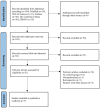Efficacy on knee function of Kinesio taping among individuals with anterior cruciate ligament reconstruction: A systematic review
- PMID: 38421970
- PMCID: PMC10903864
- DOI: 10.1371/journal.pone.0299008
Efficacy on knee function of Kinesio taping among individuals with anterior cruciate ligament reconstruction: A systematic review
Abstract
Objective: This study aims to evaluate systematically the efficacy of Kinesio taping (KT) on the knee function of individuals who undergo anterior cruciate ligament reconstruction (ACLR).
Methods: This study was registered in PROSPERO (registration number CRD42023399885) on February 26, 2023. Randomized controlled trials (RCTs) about the effects on the knee function of KT among individuals after ACLR were electronically searched from PubMed, Web of Science, Embase, The Cochrane Library, and EBSCO from inception to July 02, 2023. The outcome measures included six continuous variables: quadriceps strength, hamstring strength, knee swelling, knee flexion angle, Lysholm knee function score, and Visual Analog Scale (VAS) pain scores. The Cochrane Risk Bias Assessment Tool was used to evaluate the quality of the included literature.
Results: Seven RCTs including 278 patients who underwent ACLR were included in the systematic review. One of three (33%) studies found a remarkable increase in quadricep strength associated with the use of KT compared with the control group. Two of two (100%) studies found substantial increases in hamstring strength associated with KT. Two of four (50%) studies reported KT reduced knee swelling. Two of five (40%) studies reported considerable improvements in knee flexion angle in the groups that used KT. All three (100%) studies found KT did not improve Lysholm knee function scores. Three of four (75%) studies noted a significant reduction in VAS pain scores associated with KT.
Conclusion: KT may help improve hamstring strength and reduce knee swelling and pain in patients after ACLR. Further studies are needed to determine the effects of KT on quadricep strength and knee flexion angle.
Copyright: © 2024 Chen et al. This is an open access article distributed under the terms of the Creative Commons Attribution License, which permits unrestricted use, distribution, and reproduction in any medium, provided the original author and source are credited.
Conflict of interest statement
The authors have declared that no competing interests exist.
Figures
Similar articles
-
Short-Term Effects of the Kinesio Taping® on Early Postoperative Hip Muscle Weakness in Male Patients With Hamstring Autograft or Allograft Anterior Cruciate Ligament Reconstruction.J Sport Rehabil. 2019 May 1;28(4):311-317. doi: 10.1123/jsr.2017-0219. Epub 2018 Dec 12. J Sport Rehabil. 2019. PMID: 29252113 Clinical Trial.
-
Efficacy on pain and knee function of Kinesio taping among patients with patellofemoral pain syndrome: a systematic review and meta-analysis.BMC Musculoskelet Disord. 2025 Apr 21;26(1):388. doi: 10.1186/s12891-025-08627-7. BMC Musculoskelet Disord. 2025. PMID: 40259274 Free PMC article.
-
Effect of Postoperative Kinesio Taping on Knee Edema, Pain, and Range of Motion After Total Knee Arthroplasty and Anterior Cruciate Ligament Reconstruction: A Systematic Review and Meta-analysis of Randomized Clinical Trials.JBJS Rev. 2024 Mar 15;12(3). doi: 10.2106/JBJS.RVW.23.00221. eCollection 2024 Mar 1. JBJS Rev. 2024. PMID: 38489396
-
Kinesio taping as a treatment method in the acute phase of ACL reconstruction: A double-blind, placebo-controlled study.Acta Orthop Traumatol Turc. 2016 Dec;50(6):628-634. doi: 10.1016/j.aott.2016.03.005. Epub 2016 Oct 24. Acta Orthop Traumatol Turc. 2016. PMID: 27784622 Free PMC article. Clinical Trial.
-
Comparison of hamstring and quadriceps strength after anatomical versus non-anatomical anterior cruciate ligament reconstruction: a retrospective cohort study.BMC Musculoskelet Disord. 2021 May 18;22(1):452. doi: 10.1186/s12891-021-04350-1. BMC Musculoskelet Disord. 2021. PMID: 34006272 Free PMC article.
Cited by
-
PRP platelet-rich plasma injection combined with aquatic exercise therapy improves functional recovery of basketball players with knee joint injury.Am J Transl Res. 2024 Oct 15;16(10):5700-5707. doi: 10.62347/PIQQ7236. eCollection 2024. Am J Transl Res. 2024. PMID: 39544749 Free PMC article.
References
-
- Ardern CL, Taylor NF, Feller JA, Webster KE. Fifty-five per cent return to competitive sport following anterior cruciate ligament reconstruction surgery: an updated systematic review and meta-analysis including aspects of physical functioning and contextual factors. Br J Sports Med. 2014;48(21):1543–52. doi: 10.1136/bjsports-2013-093398 - DOI - PubMed
Publication types
MeSH terms
LinkOut - more resources
Full Text Sources
Medical



